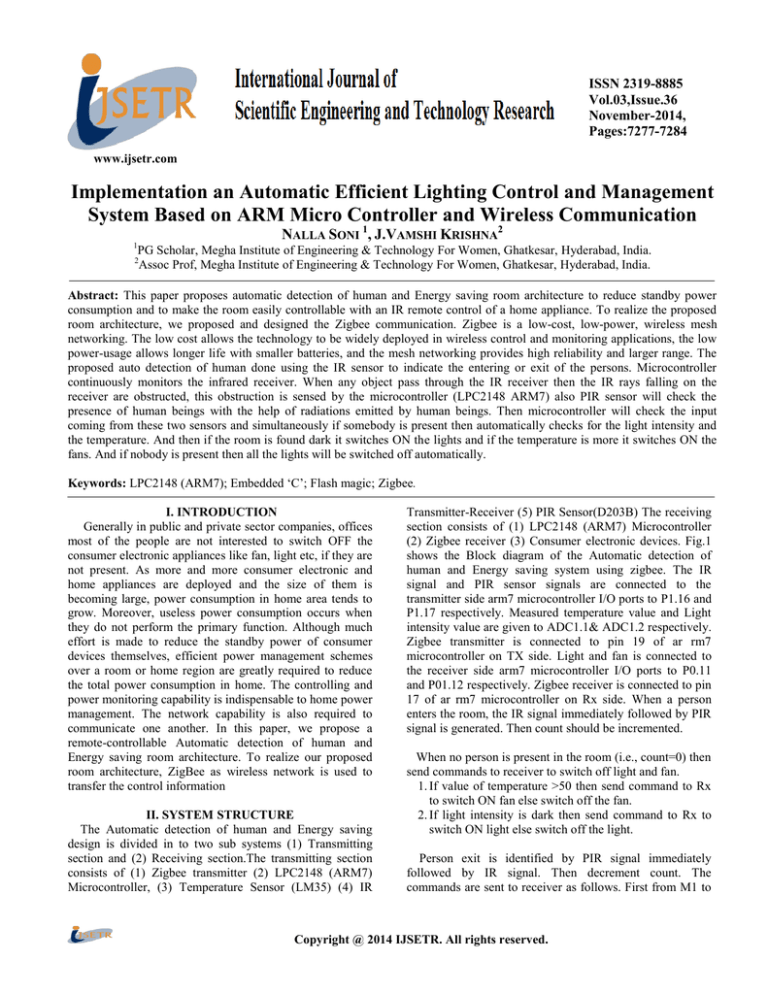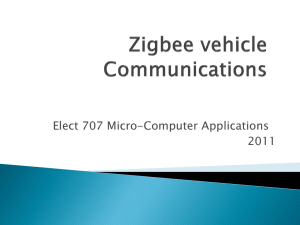
ISSN 2319-8885
Vol.03,Issue.36
November-2014,
Pages:7277-7284
www.ijsetr.com
Implementation an Automatic Efficient Lighting Control and Management
System Based on ARM Micro Controller and Wireless Communication
NALLA SONI 1, J.VAMSHI KRISHNA2
1
PG Scholar, Megha Institute of Engineering & Technology For Women, Ghatkesar, Hyderabad, India.
Assoc Prof, Megha Institute of Engineering & Technology For Women, Ghatkesar, Hyderabad, India.
2
Abstract: This paper proposes automatic detection of human and Energy saving room architecture to reduce standby power
consumption and to make the room easily controllable with an IR remote control of a home appliance. To realize the proposed
room architecture, we proposed and designed the Zigbee communication. Zigbee is a low-cost, low-power, wireless mesh
networking. The low cost allows the technology to be widely deployed in wireless control and monitoring applications, the low
power-usage allows longer life with smaller batteries, and the mesh networking provides high reliability and larger range. The
proposed auto detection of human done using the IR sensor to indicate the entering or exit of the persons. Microcontroller
continuously monitors the infrared receiver. When any object pass through the IR receiver then the IR rays falling on the
receiver are obstructed, this obstruction is sensed by the microcontroller (LPC2148 ARM7) also PIR sensor will check the
presence of human beings with the help of radiations emitted by human beings. Then microcontroller will check the input
coming from these two sensors and simultaneously if somebody is present then automatically checks for the light intensity and
the temperature. And then if the room is found dark it switches ON the lights and if the temperature is more it switches ON the
fans. And if nobody is present then all the lights will be switched off automatically.
Keywords: LPC2148 (ARM7); Embedded „C‟; Flash magic; Zigbee.
I. INTRODUCTION
Generally in public and private sector companies, offices
most of the people are not interested to switch OFF the
consumer electronic appliances like fan, light etc, if they are
not present. As more and more consumer electronic and
home appliances are deployed and the size of them is
becoming large, power consumption in home area tends to
grow. Moreover, useless power consumption occurs when
they do not perform the primary function. Although much
effort is made to reduce the standby power of consumer
devices themselves, efficient power management schemes
over a room or home region are greatly required to reduce
the total power consumption in home. The controlling and
power monitoring capability is indispensable to home power
management. The network capability is also required to
communicate one another. In this paper, we propose a
remote-controllable Automatic detection of human and
Energy saving room architecture. To realize our proposed
room architecture, ZigBee as wireless network is used to
transfer the control information
II. SYSTEM STRUCTURE
The Automatic detection of human and Energy saving
design is divided in to two sub systems (1) Transmitting
section and (2) Receiving section.The transmitting section
consists of (1) Zigbee transmitter (2) LPC2148 (ARM7)
Microcontroller, (3) Temperature Sensor (LM35) (4) IR
Transmitter-Receiver (5) PIR Sensor(D203B) The receiving
section consists of (1) LPC2148 (ARM7) Microcontroller
(2) Zigbee receiver (3) Consumer electronic devices. Fig.1
shows the Block diagram of the Automatic detection of
human and Energy saving system using zigbee. The IR
signal and PIR sensor signals are connected to the
transmitter side arm7 microcontroller I/O ports to P1.16 and
P1.17 respectively. Measured temperature value and Light
intensity value are given to ADC1.1& ADC1.2 respectively.
Zigbee transmitter is connected to pin 19 of ar rm7
microcontroller on TX side. Light and fan is connected to
the receiver side arm7 microcontroller I/O ports to P0.11
and P01.12 respectively. Zigbee receiver is connected to pin
17 of ar rm7 microcontroller on Rx side. When a person
enters the room, the IR signal immediately followed by PIR
signal is generated. Then count should be incremented.
When no person is present in the room (i.e., count=0) then
send commands to receiver to switch off light and fan.
1. If value of temperature >50 then send command to Rx
to switch ON fan else switch off the fan.
2. If light intensity is dark then send command to Rx to
switch ON light else switch off the light.
Person exit is identified by PIR signal immediately
followed by IR signal. Then decrement count. The
commands are sent to receiver as follows. First from M1 to
Copyright @ 2014 IJSETR. All rights reserved.
NALLA SONI , J.VAMSHI KRISHNA
Zigbee TX and then to Zigbee Rx and then to M2.The
Step 3: Check for IR interrupt signal. If it is followed by
devices are operated using P0.11 and P0.12 values in
PIR signal, then increment count.
M2.When person is present (i.e., count>0),
Step4: When count >0 do the following:
1. If temperature >50 then send a command to
receiver to switch ON fan else send a command to
receiver to switch OFF fan
2. If room intensity is dark then send a command to
receiver to switch ON light else send a command to
receiver to switch OFF light.
3. Check for PIR signal. If it is followed by IR
interrupt signal. Then decrement count.
Step 5: When count<0 send command to receiver to switch
OFF fan and light.
Step 6: Repeat the steps 3, 4 and 5 in parallel.
Fig3. Receiver Section.
Fig1. Block diagram of the Automatic detection of
human and Energy saving system using zigbee.
Fig2. Transmission Section.
III ALGORITHM
Step1: Start
Step2: Initiate microcontrollers M1, M2.
Fig4. Transmission and receive sections.
International Journal of Scientific Engineering and Technology Research
Volume.03, IssueNo.36, November-2014, Pages: 7271-7276
Implementation an Automatic Efficient Lighting Control and Management System Based on ARM Micro Controller
and Wireless Communication
Fig5. Schematic view of Energy-Saving Room Architecture Tx Section.
International Journal of Scientific Engineering and Technology Research
Volume.03, IssueNo.36, November-2014, Pages: 7277-7284
Implementation an Automatic Efficient Lighting Control and Management System Based on ARM Micro Controller
and Wireless Communication
Fig.6. Schematic view of Energy-Saving Room Architecture Rx Section.
International Journal of Scientific Engineering and Technology Research
Volume.03, IssueNo.36, November-2014, Pages: 7277-7284
Implementation an Automatic Efficient Lighting Control and Management System Based on ARM Micro Controller
and Wireless Communication
IV SYSTEM FLOW CHART
V. CONCLUSION
We proposed Automatic detection of human and Energy
saving room architecture based on Zigbee Communication.
With the help of this architecture, we can control the power
when a person enters in the room and exit the room
automatically along with we considered additional
requirements also. This can be extended to more number of
consumer electronic and home appliances also.
VI. REFERENCES
[1] IEA, “Fact Sheet: Standby Power Use and the IEA “1
Watt Plan”,” Apr.2007. http://www.iea.org/textbase/papers/
2007/standby_fact.pdf.
[2] IEA, “Reducing Standby Power Waste to Less Than 1
Watt: A Relevant Global Strategy that Delivers,”
2002.http://www.iea.org/Textbase/papers/2002/globe02.pdf
[3] Calboun B.H., Chandrakasan A.P., “Standby Power
Reduction Using Scaling and Carry Flip-Flop Structures,”
IEEE Journal of Solid-State Circuits, vol.39, no.9, pp.15041511, Sep. 2004.
[4] Bo-Teng Huang, Ko-Yen Lee and Yen-Shin Lai,
“Design of a Two-Stage AC/DC Converter with Standby
Power Losses Less Than 1 W,”Proceedings of Power
Conversion Conference 2007, pp.1630-1635, Apr.2007.
[5] Joon Heo et al, “Design and Implementation of Control
Mechanism for Standby Power Reduction,” IEEE Trans. on
Consumer Electronics, vol.53, no.1, pp.179-185, Feb. 2008.
[6] Chia-Hung Len, Ying-Wen Bai, and Ming-Bo Lin,
“Remote- Controllable Power Outlet System for Home
Power Management,” IEEE Trans. on Consumer Electronics
, vol.53, No.4, pp.1634-1641, Nov. 2007.
[7] Chi-Hung, Chi-Hsiung Lin, Ying-Wen Bai, Ming-Fong
Liu and Ming- Bo Lin, “Remotely Controllable Outlet
System for Home Power Management,” Proceedings of the
2008 International Symposium on Consumer Electronics,
Algarve, Portugal, 14-16 Apr. 2008.
[8] Jui-Yu Cheng, Min-Hsiung Hung, and Jen-Wei Chang,
“A ZigBee-Based Power Monitoring System with Direct
Load ControlCapabilities,” Proceedings of the 2007 IEEE
International Conferenceon Networking, Sensing and
Control, London, UK, 15-17 Apr. 2007
[9] Ying-Wen Bai and Chi-Huang Hung, “Remote Power
On/Off Control and Current Measurement for Home
Electric Outlets Based on a Low- Power Embedded Board
and ZigBee Communication,” Proceedings of
[10] the 2008 International Symposium on Consumer
Electronics, Algarve, Portugal, 14-16 Apr. 2008.
International Journal of Scientific Engineering and Technology Research
Volume.03, IssueNo.36, November-2014, Pages: 7277-7284
NALLA SONI , J.VAMSHI KRISHNA
[11] asahiro Inoue, Toshiyasu Higuma, Yoshiaki Ito,
Author’s Profile:
Noriyuki Kushiro, and Hitoshi Kubota, “Network
Nalla. Sony has completed the graduation in Swamy
Architecture for Home Energy Management System,” IEEE
ramananda tirtha Institute Of Science & technology and
Trans. on Consumer Electronics, vol.49,no.3, pp.606-613,
pursuing M.Tech in Megha Institute Of Engineering &
Aug. 2003.
Technology For Women Ghatkesar,Hyderabad in embedded
[12] IEEE Std. 802.15.4 Wireless Medium Access Control
system interested to do research in embedded systems.
(MAC) and Physical Layer (PHY) Specification for LowRate Wireless Personal Area Networks, May 2003.
Mr. J. Vamshi Krishna received the M.Tech. degree in
[15] ZigBee Alliance, ZigBee Specification Version 1.0,
VLSI Design from Aurora Engineering Collage, Parvatpur,
Dec. 2004.
Uppal, Hyderabad. B.Tech. in ECE from Swarna Bharathi
[13] Gutierrez, J.A., Naeve, M., Callaway, E., Bourgeois,
Inst. of Science & Technology, Khammam. Currently
M., Mitter, V., and Heile, B., “IEEE 802.15.4: A
working as HOD in Megha Institute Of Engineering &
Developing Standard for Low-Power Low- Cost Wireless
Technology For Women, Ghatkesar, Hyderabad in the Dept.
Personal Area Networks,” IEEE Network, vol.15, no.5,
of Electronics & Communication Engg.
pp.12-19, Sept. 2001.
[14] Callaway, E., Bahl, V., Gorday, P., Gutierrez, J.A.,
Hester, L. Naeve, M., Heile, B.,”Homenetworking with
IEEE 802.15.4: A Developing Standard for Low-Rate
Wireless Personal Area Networks,” IEEE Communications
Magazine, vol.40, no.8, pp.70-77, Aug. 2002.
[15] Jin Ho Kim, Jun Wook Lee, Yong Joon Lee, and JaeCheol Ryou, “A Lightweight NEMO Protocol to Support
6LoWPAN,” ETRI Journal, vol.30, no.5, pp.685-695, Oct.
2008.
[16] Trung-Kien Nguyen et al, “Low-Power Direct
Conversion Transceiver for 915 MHz Band IEEE 802.15.4b
Standard Based on 0.18 um CMOS Technology,” ETRI
Journal, vol.30, no.1, pp.33-46, Feb. 2008.
[17] Ki Chool Yang and Sun Young Kim, “Automatically
Standby Power Cut-Off Plug Socket,” Korea Patent,
0801042 (2008).
[18] Jinsoo Han, Intark Han and Kwang-Roh Park,
“ZigBee-based IR Remote Control Repeater and its Control
Message Frame Format,” Proceedings of the 2008
International Symposium on Consumer Electronics,
Algarve, Portugal, 14-16 Apr. 2008.
International Journal of Scientific Engineering and Technology Research
Volume.03, IssueNo.36, November-2014, Pages: 7271-7276





